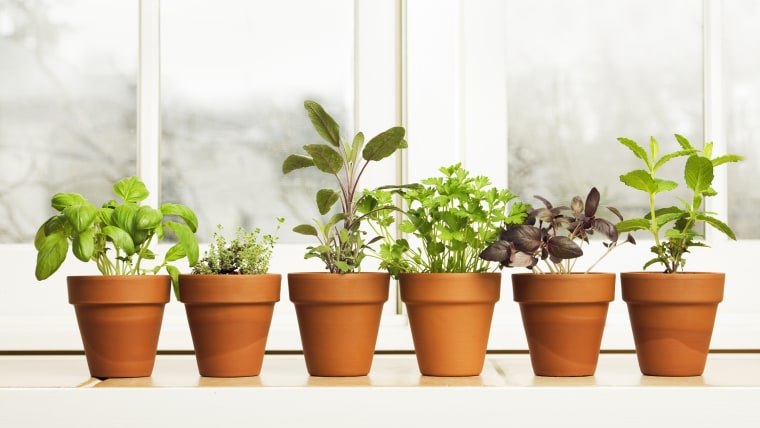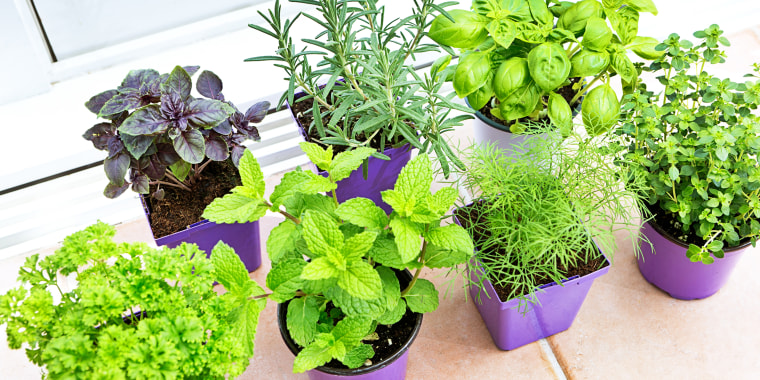When testing out a new recipe, one of the most expensive investments are herbs. Priced per bunch, these green goodies pack mega flavor, but also pad the check-out total.
That’s one reason why many people are hopping on the trend of creating an indoor herb garden. Not only do we improve our green thumb by growing everything from rosemary to basil, but we can save mega money via these sprouts — and they taste fresh! The key, of course, is getting started and setting yourself up for success. Here, experts provide everything you need to know about planting, nurturing and reaping the benefits of your very own indoor herb garden.
Find the best spot for natural sunlight
Whether you intend to plant each seed in an individual pot or invest in a multiplant container, Joyce Mast, Bloomscape's in-house plant expert, says location is everything. Herbs need the right amount of vitamin D to thrive. In fact, they may even need more than other plants, with a recommended six hours daily, according to Mast. When at all possible, south-facing light is best but it really depends on the type of herb and their specific needs.
George Pisegna, the deputy director and chief of horticulture for The Horticulture Society of New York recommends shopping around for healthy plants with strong root systems. To identify what will work for your home, he suggests scouting out the sunlight first. “Herbs like basil, parsley, oregano, rosemary and tarragon are perfect for a sunny location. In a less sunny area try herbs like chives, mint, thyme, chervil and sage,” he said.
If you don’t have a stream of natural sunlight, Mast says it is beneficial to invest in growing lights. Inexpensive and effective, these can be set on timers to ensure the herbs receive exactly what they need. Especially for those who are located in a stretch of the country that has shorter winter days, these are a no-brainer for your indoor herb garden.

Use potting mix and fertilizer
Now, you have a blueprint of your home and it’s streams of sunlight. You’re ready to pick the optimal seed and start your indoor herb garden. Rather than using the soil typically found in a garden, Mast suggests opting for a potting mix with a fertilizer. How come? She explains potting is not as dense or heavy, which enables both water and air to reach the roots. Her favorite is Fox Farm Organic Potting Soil, which is fully mixed and loaded with what you need to begin planting your herbs.
After the initial planting, Pisegna says to keep the soil moist — but not wet. It should dry out before you add any more water. He encourages herb parents to read the potting mix ingredients carefully to know when to add more soil or fertilizer. “If you use a soil that contains compost, you will not have to fertilize for a few months. After that, use an organic houseplant fertilizer once a month,” he offered.
Make sure your pots have drainage holes
Are you guilty of being an overprotecting, overbearing — and, ahem, — overwatering plant parent? It’s better to go easy on the TLC, as Mast puts it, since the fastest way to ruin an herb is to allow the roots to sit in water. This quickly leads to root rot, and eventually a dead plant. That’s why choosing pots with drainage holes and saucers will lead to healthier herbs. “The drainage holes must be small enough to keep the soil in the pot but large enough to drain water from the pot,” she continues. “When watering, allow the water to flow freely through the bottom hole and give it enough time to expel all the excess water. Always make sure the saucer is free of any standing water.”
Be mindful of temperature
Most indoor herb garden lovers crave fresh bites all year-round. This requires a little leg work, since you may need to move your herb babies seasonally or invest in tools that will keep them toasty. As the director of Reynolda Gardens of Wake Forest University, Jon Roethling explains that most herbs prefer a temperature of 70 degrees. Most buds can remain healthy with a dip down to 50 degrees, but anything lower can threaten them. If your indoor thermostat isn’t always within this range, make sure to invest in a herb garden plant warmer, which can regulate and maintain their levels.
Don’t neglect the herbs as they grow
The good — and tricky — news about herbs is that the more you use them, the more they grow. This is helpful for amateur home chefs, but also requires more attention to detail that can be tough with a busy lifestyle. Mast says that unlike some plants, herbs aren’t the type you can pot, water and leave alone; rather, they require pruning and trimming to produce a bushy growth. She suggests leaving one-third of the leaves attached to allow them to sprout. And be mindful of overgrowth. “To keep your herbs producing leaves instead of seeds, always remove the old flowers to prevent them from going to seed. Cutting off the spent flowers will trick the herbs into growing more leaves,” she recommends.
Not sure what to use? Mast suggests Hydroponic Micro-tip Blades. “They allow you to snip off specific leaves cleanly and quickly without disturbing the rest of the plant,” she shares.

